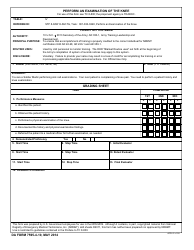DA Form 7595-4-12 Perform an Examination of the Wrist
What Is DA Form 7595-4-12?
This is a military form that was released by the U.S. Department of the Army (DA) on May 1, 2014. The form, often mistakenly referred to as the DD Form 7595-4-12, is a military form used by and within the U.S. Army. As of today, no separate instructions for the form are provided by the DA.
FAQ
Q: What is DA Form 7595-4-12?
A: DA Form 7595-4-12 is a form used to perform an examination of the wrist.
Q: What is the purpose of performing an examination of the wrist?
A: The purpose of performing an examination of the wrist is to assess any potential injuries or conditions affecting the wrist.
Q: Who uses DA Form 7595-4-12?
A: DA Form 7595-4-12 is used by medical professionals, such as doctors or healthcare providers, to document and evaluate wrist examinations.
Q: What information is recorded on DA Form 7595-4-12?
A: DA Form 7595-4-12 includes information about the patient, the examination findings, and any recommended treatments or follow-up actions.
Q: Is the examination of the wrist painful?
A: The examination of the wrist may involve some discomfort, but it should not be excessively painful. The medical professional will take measures to minimize any discomfort during the examination.
Q: Is an examination of the wrist covered by insurance?
A: The coverage for an examination of the wrist may vary depending on your insurance provider and specific plan. It is recommended to check with your insurance company to determine the coverage.
Q: How long does a wrist examination take?
A: The duration of a wrist examination can vary depending on various factors, such as the complexity of the case and the individual provider's practices. It generally takes around 10-20 minutes.
Q: What should I do if I have wrist pain?
A: If you have wrist pain, it is advisable to seek medical attention from a healthcare professional. They can evaluate your condition and provide appropriate treatment or recommendations.
Q: Can I return to normal activities after a wrist examination?
A: In most cases, you should be able to resume normal activities after a wrist examination. However, it is important to follow any recommendations or restrictions provided by the healthcare professional.
Q: Are there any risks associated with a wrist examination?
A: A wrist examination is generally a safe procedure. However, there may be minimal risks such as discomfort during the examination or potential bruising. Serious complications are rare.
Q: Can I perform a self-examination of my wrist?
A: While you can perform a basic self-examination of your wrist, it is recommended to seek professional medical attention for a comprehensive evaluation, especially if you have significant pain or concerns.
Q: How often should I get my wrist examined?
A: The frequency of wrist examinations depends on individual circumstances, such as pre-existing conditions, injuries, or symptoms. It is best to consult with a medical professional to determine the appropriate schedule for your situation.
Q: What are some common wrist conditions that may require examination?
A: Some common wrist conditions that may require examination include sprains, strains, fractures, tendonitis, arthritis, carpal tunnel syndrome, and ligament injuries.
Q: What treatments or interventions may be recommended after a wrist examination?
A: The recommended treatments or interventions after a wrist examination can vary depending on the specific condition or injury. It may include rest, immobilization, pain medication, physical therapy, or in some cases, surgical intervention.
Q: Can a wrist examination diagnose all possible wrist conditions?
A: While a wrist examination is a valuable diagnostic tool, it may not be able to diagnose all possible wrist conditions. Further tests or imaging studies may be necessary to confirm a diagnosis.
Q: Are children eligible for a wrist examination?
A: Yes, children are eligible for a wrist examination if they have wrist-related issues or injuries. In such cases, it is best to consult with a pediatrician or healthcare provider specialized in pediatric care.
Q: What should I wear for a wrist examination?
A: For a wrist examination, it is advisable to wear loose and comfortable clothing that allows easy access to the wrist area. Avoid wearing tight sleeves or accessories that may interfere with the examination.
Q: Can I bring someone with me to a wrist examination?
A: You may bring a companion or support person to a wrist examination if it makes you feel more comfortable. However, it is best to check with the healthcare provider beforehand as some facilities may have specific policies on accompanying individuals.
Q: Can a wrist examination detect hidden wrist injuries?
A: A wrist examination can often detect visible signs of injuries or conditions, but it may not always detect hidden or internal injuries. Additional imaging tests, such as X-rays or MRI scans, may be required to assess internal structures.
Q: Who should I contact if I have questions about a wrist examination?
A: If you have questions about a wrist examination, it is recommended to contact the healthcare provider or facility where the examination will take place. They can address your concerns and provide relevant information.
Form Details:
- A 1-page document available for download in PDF;
- The latest version available from the Army Publishing Directorate;
- Editable, free, and easy to use;
- Fill out the form in our online filing application.
Download an up-to-date fillable DA Form 7595-4-12 down below in PDF format or browse hundreds of other DA Forms stored in our online database.







